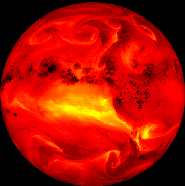
An infrared view of the Earth
As we enter the mid-infrared region of the spectrum, the cool stars begin to fade out and cooler objects such as planets, comets and asteroids come into view. Planets absorb light from the sun and heat up. They then re-radiate this heat as infrared light. This is different from the visible light that we see from the planets which is reflected sunlight. The planets in our solar system have temperatures ranging from about 53 to 573 degrees Kelvin. Objects in this temperature range emit most of their light in the mid-infrared. For example, the Earth itself radiates most strongly at about 10 microns. Asteroids also emit most of their light in the mid-infrared making this wavelength band the most efficient for locating dark asteroids. Infrared data can help to determine the surface composition, and diameter of asteroids.
IRAS mid-infrared view of Comet IRAS-Araki-Alcock
Dust warmed by starlight is also very prominent in the mid-infrared. An example is the zodiacal dust which lies in the plane of our solar system. This dust is made up of silicates (like the rocks on Earth) and range in size from a tenth of a micron up to the size of large rocks. Silicates emit most of their radiation at about 10 microns. Mapping the distribution of this dust can provide clues about the formation of our own solar system. The dust from comets also has strong emission in the mid-infrared.Warm interstellar dust also starts to shine as we enter the mid-infrared region. The dust around stars which have ejected material shines most brightly in the mid-infrared. Sometimes this dust is so thick that the star hardly shines through at all and can only be detected in the infrared. Protoplanetary disks, the disks of material which surround newly forming stars, also shines brightly in the mid-infrared. These disks are where new planets are possibly being formed.

No comments:
Post a Comment